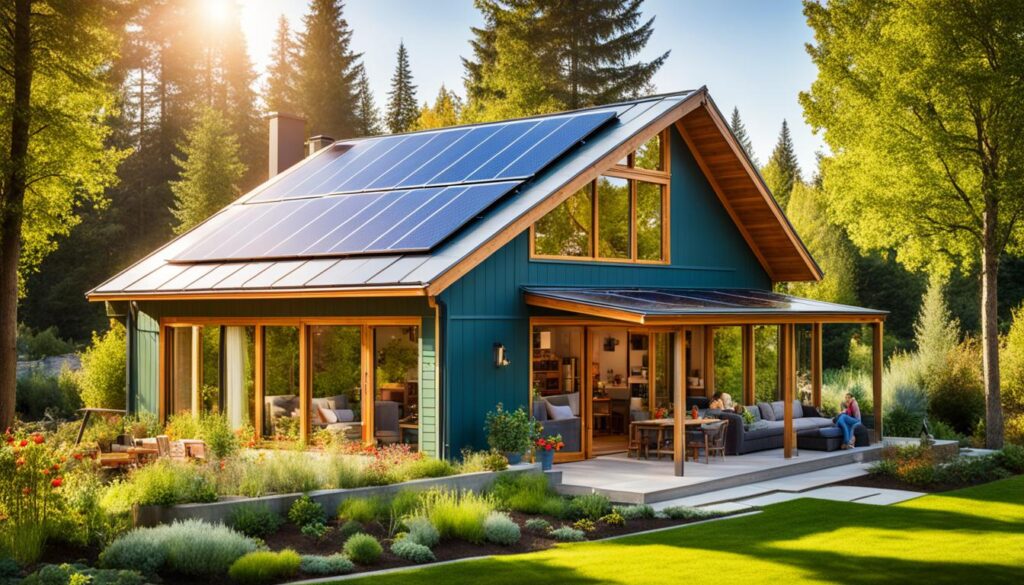Embracing an eco-friendly lifestyle is not just a trend; it’s a responsibility we all share in order to protect our planet. Fortunately, sustainable living practices can be incorporated into everyday life with ease and efficiency. From switching off appliances to considering our dietary choices, every action counts towards fostering a more environmentally friendly living space. This journey towards a greener existence starts with energy conservation—a fundamental step in reducing our carbon footprint.
Moreover, by adopting simple sustainable tips and making mindful choices such as selecting efficient LED bulbs or reducing meat consumption, we collectively move towards a brighter, cleaner future. It’s the culmination of these daily practices that coalesces into the broader concept of green living, where each individual effort lays the bricks for a sustainable global community.
Key Takeaways
- Turning off electrical appliances to save energy and cut costs.
- Replacing traditional bulbs with LED alternatives to enhance energy efficiency.
- Incorporating home insulation for maintaining temperature and reducing emissions.
- Reducing meat consumption as a step towards minimizing one’s environmental footprint.
- Composting and sustainable food management to significantly lower waste generation.
- Conscious consumption by selecting renewables and eco-friendly products.
- Opting for public transportation and electric vehicles to decrease pollution.
Embracing the Eco-Friendly Lifestyle
In the modern age, where environmental consciousness is more than a trend, sustainable living has evolved into a fundamental aspect of daily life. It’s vital to acknowledge that every individual can partake in fostering an eco-friendly routine that not only benefits oneself but also the planet at large. This lifestyle pivot entails a slew of simple yet impactful green living habits which, when combined, can foster a healthier environment.
One notable practice is the adoption of energy-efficient appliances, a straightforward step with substantial benefits. But at the heart of sustainable living is the shift towards renewable energy. Companies like Good Energy, which procure electricity from a network of renewable generators, exemplify the significant strides being taken in this domain. Consider incorporating solar power solutions into your home to actively reduce your carbon footprint.
However, sustainability isn’t confined to grand gestures; even seemingly inconsequential actions can accumulate to produce profound effects. For instance, the simple act of carrying a canvas bag or utilizing refillable containers signifies a commitment to minimizing single-use plastics, thus preserving ecosystems. Moreover, retrofits like LED lighting not only offer longevity but also lessen the demand on our energy grids. By adopting such habits, we inch closer to a world where sustainable living isn’t an option but a norm.
- Choose appliances with energy efficiency in mind
- Participate in supporting companies that invest in renewable energy
- Implement minor changes in everyday life, like using canvas bags and refillable bottles
- Opt for LED lighting to lower energy consumption
As conscientious inhabitants of this planet, it falls upon us to perpetuate an eco-friendly routine, making green living not merely a choice, but a steadfast habit. It’s our collective endeavor that will pave the way towards a sustainable future for all beings sharing this Earth.
Energy Conservation: A Cornerstone of Sustainable Living
At the heart of a sustainable lifestyle lies the essential practice of energy conservation, a critical measure for carbon footprint reduction. Simple behavioral changes can make a significant impact, such as the deliberate action of turning off appliances when not in use rather than leaving them in a power-sipping standby mode. Achieving optimal energy efficiency in the household has become more accessible with the advancement of energy-efficient appliances and innovative home energy solutions.
Maximizing Energy-Efficiency in Home Appliances
Investing in appliances with superior energy ratings not only lowers electricity consumption but also actively contributes to the preservation of our environment. Harnessing the benefits of renewable electricity, these state-of-the-art machines are designed to operate at peak efficiency while easing the burden on both the ecosystem and your utility expenses.
- Refrigerators with advanced insulation technology save significant power.
- Energy-efficient washing machines consume less water, reducing both energy and natural resource usage.
- Smart thermostats ensure homes are heated and cooled in the most efficient manner possible.
Integrating these technological advancements within the household aligns perfectly with a sustainable ethos and the drive towards a lesser environmental footprint.
Alternative Energy Sources: Solar and Heat Pumps
For homeowners looking to take a bold step towards energy autonomy and greener living, the adoption of solar panels and air source heat pumps serves as an ideal choice. These cutting-edge technologies offer a path to generating renewable electricity directly on-site, thereby fostering a substantially more sustainable home environment.
Known for their ability to effectively extract heat from the outside air, air source heat pumps provide heating and cooling solutions with great efficiency. Similarly, solar panels convert the abundant energy of the sun into clean, green electricity, drastically cutting down reliance on fossil fuels.
| Energy Solution | Benefits | Considerations |
|---|---|---|
| Air Source Heat Pumps | Reduced heating costs, low maintenance, eco-friendly | Initial setup cost, performance efficiency in cold climates |
| Solar Panels | Renewable energy generation, government incentives, long-term savings | Site suitability, installation cost, intermittent energy production |
Companies such as Good Energy are pioneering change by sourcing their power from a wide network of independent, renewable generators; this not only catalyzes the shift towards renewable electricity but also supports the global impetus for sustainable development.
In conclusion, both the implementation of energy-conserving appliances and the transition to alternative energy sources signal a robust commitment to the health of our planet. By leveraging these modern solutions, we can individually and collectively move towards a more sustainable and environmentally responsible way of life.
Choosing a Diet Lower in Meat for Environmental Benefits
Exploring the realm of plant-based diets and red meat reduction is not just a lifestyle trend; it’s a critical move towards shrinking our carbon footprint and reducing the environmental impact of meat production. By integrating more plant-based meals into our weekly routines, we each play a role in a collective effort to alleviate the stresses placed on our planet.
It’s important to understand how a plant-centric diet can lead to remarkable decreases in GHG emissions. We’ve outlined some of the direct benefits below, illustrating how your food choices can lead to meaningful change.
- Reduced Greenhouse Gas Emissions: The meat industry significantly contributes to methane and CO2 production. Substituting meat with plant-based options can lead to a substantial drop in these emissions.
- Water Conservation: Animal agriculture is notoriously water-intensive. By opting for plants, we drastically cut down on water usage.
- Diminished Habitat Destruction: Industrial meat production often leads to deforestation and loss of biodiversity. A move towards a plant-based diet helps preserve precious ecosystems.
| Food Choice | Carbon Footprint (CO2 eq per kg) | Water Usage (liters per kg) |
|---|---|---|
| Beef (red meat) | 27 kg | 15,415 liters |
| Lentils (plant-based) | 0.9 kg | 50 liters |
| Tomatoes (plant-based) | 1.1 kg | 214 liters |
As highlighted, even partial adherence to a plant-based diet can contribute to environmental benefits that outweigh the challenges of dietary change. The data shows a stark contrast in the carbon footprint and resource use between meat and plant foods, emphasizing the environmental impact of meat. By consciously making choices that favor the environment, each meal becomes an opportunity to positively influence our planet’s future.
Adopting the ‘Waste Not, Want Not’ Philosophy
Embracing food waste prevention is a critical step towards building a more sustainable kitchen. In the spirit of ‘waste not, want not,’ we can all practice reducing our impact on the planet by incorporating thoughtful habits into our daily routines. These acts not only conserve resources but also contribute significantly to landfill reduction.
In the pursuit of a sustainable kitchen, here are some key practices:
- Freezing leftovers to extend their life and prevent unnecessary waste.
- Mindfully planning meals to use ingredients before they spoil, supporting food waste prevention.
- Starting a compost bin to transform food scraps into nutrient-rich soil, encouraging the cycle of composting.
By taking these steps, we promote sustainable kitchen practices that have a far-reaching positive impact on the environment. Additionally, preventing food waste is an excellent way to lessen the continual strain on our landfills and reduce the production of greenhouse gases like CO2 and methane.
| Practice | Benefit | Impact on the Environment |
|---|---|---|
| Freezing Leftovers | Food preservation | Reduces the amount of waste going to landfill |
| Meal Planning | Efficient use of groceries | Decreases food surplus and waste production |
| Composting | Creation of natural fertilizer | Minimizes methane emissions from landfills |
Ultimately, by actively taking part in landfill reduction, engaging in composting, and establishing sustainable kitchen practices, we can all contribute to a healthier planet. Food waste prevention is more than just a choice; it’s a responsibility that comes with an array of environmental benefits contributing to the welfare of our ecosystem.
Conscious Consumerism and its Environmental Impact
Embracing conscious consumerism is not just a trend—it’s a commitment to making purchases that positively influence the globe. By focusing on recycling efforts, we can reduce excessive waste and conserve valuable resources. When shoppers incorporate plastic reduction into their daily lives by selecting alternatives to single-use plastics, they help safeguard our oceans and wildlife.
Eco-friendly shopping goes beyond the products we choose—it also encompasses how and where we buy them. Privileging local consumption supports neighborhood businesses, reducing carbon emissions from long-distance transportation and strengthening local economies. This approach forms a pivotal part of a sustainability strategy that links community health to environmental stewardship.
- Recycling programs and facilities
- Products designed for reusability or with recycled content
- Local farmers’ markets and community-supported agriculture (CSA)
- Businesses with a commitment to sustainable practices
Additionally, conscious consumerism extends beyond tangible products to the experiences we choose. Opting to explore natural reserves close to home rather than booking flights for distant holiday destinations can significantly decrease one’s carbon footprint and foster an appreciation for local natural beauty.
In conclusion, the power of consumer choice cannot be underestimated when considering its broad environmental impact. Every purchase decision becomes an opportunity to contribute to a sustainable future and motivate others to do the same. By investing in recycling, reducing plastic use, shopping eco-friendly, and supporting local ventures, we cultivate a greener world for ourselves and generations to come.
Efficient Home Insulation for an Eco-Friendly Abode
Investing in home insulation is a strategic step towards achieving energy savings and creating an eco-friendly housing environment. High-quality insulation acts as a protective barrier against heat loss during the winter and heat gain during the summer, which can lead to a significant reduction in the need for heating and air conditioning. This not only helps to conserve energy but also reduces greenhouse gas emissions, making it a quintessential aspect of green home improvements.
The benefits of upgrading your home with top-notch insulation materials cannot be understated; it’s a move that pays dividends in both the short and long term. To give you a clearer perspective on the potential energy savings that can be achieved, let’s consider some of the most effective insulation applications:
- Attic Insulation: A properly insulated attic can prevent warm air from escaping, thereby reducing the workload on your heating system.
- Wall Insulation: Filling gaps in existing walls with insulating materials can significantly eliminate cold drafts and enhance heat retention.
- Window Upgrades: Double or triple-glazing windows can minimize heat transfer, providing a more stable indoor climate year-round.
- Floor Insulation: Installing insulation beneath your flooring can help maintain comfortable temperatures and reduce noise levels.
Moreover, modern insulation materials have been engineered to be both effective and environmentally friendly, offering homeowners a sustainable choice for their properties. By implementing these green living solutions, one can experience not only immediate comfort but also long-term financial gain from lowered utility bills.

Beyond the practicality of insulating your home, it’s a proactive measure that supports sustainability and responsible living. A well-insulated home equates to a green home, with less energy required to heat or cool it, thereby reducing its carbon footprint. As we strive towards better eco-friendly housing solutions, the role of home insulation becomes increasingly important in our collective efforts to protect the environment.
“Good insulation slows the rate of heat transfer, making it one of the most effective and eco-friendly ways to keep your home at the ideal temperature.” – U.S. Department of Energy
In summary, the pursuit of energy savings through effective home insulation is essential for anyone looking to create an eco-friendly housing environment. Not only does it align with the greater goal of making green home improvements, but it also promotes a more sustainable and cost-effective lifestyle. By making the smart choice to insulate your home, you contribute positively to both your personal living space and the broader global ecosystem.
Sustainable Living: Practical Steps Towards a Greener Future
In the pursuit of a planet where future generations can thrive, sustainable living practices have become essential. By integrating energy-efficient lighting and greener modes of transportation into our daily lives, we take significant strides towards an eco-friendly existence. Choosing LED bulbs and favoring sustainable transportation are actionable steps that yield substantial environmental dividends. Below, we explore the practicalities of adopting these measures for a healthier, greener tomorrow.
Choosing LED Light Bulbs
Transitioning to LED bulbs is one of the simplest yet most effective methods of implementing energy-efficient lighting. With their superior longevity and energy-saving capabilities, LEDs serve as an investment in both the environment and one’s energy bills. The immediate impact is twofold: decreased energy consumption and a reduction in the waste stream of used bulbs.
Adopting Greener Transportation Methods
When contemplating sustainable transportation, we consider the integration of electric vehicles (EVs) into personal transport fleets, as well as a cultural shift towards biking and walking. These transport methods lower our dependence on fossil fuels and significantly cut back on carbon emissions. Emphasizing the importance of EVs, bicycles, and walking shoes as tools for change, addressing the urgent need for sustainable practices becomes all the more tangible.
Eco-Friendly Cleaning: Choosing Products that Protect the Planet
As we strive for a healthier environment and home, toxic chemical reduction has become paramount. Many of the products we use to clean our living spaces are laden with substances that can both pollute the environment and pose risks to our health. As we learn more about these impacts, the switch to green cleaning products is not just a trend, but a vital shift in our daily practices.
Incorporating environmentally safe cleaning practices into our routine doesn’t mean sacrificing effectiveness for ethics. In fact, many natural ingredients found in green cleaning products have been used for centuries due to their powerful cleaning properties. Let’s embrace these solutions that care for our health and the planet we call home.
Below is a comparison between traditional cleaning products and green alternatives that highlight the importance of using sustainable products for our planet’s well-being:
| Traditional Cleaning Product | Green Cleaning Alternative | Benefits of Green Alternative |
|---|---|---|
| Ammonia-based Glass Cleaners | Vinegar and Water Solution | Non-toxic, safe for children and pets |
| Bleach for Disinfecting | Hydrogen Peroxide | Biodegradable and effective against bacteria |
| Aerosol Air Fresheners | Essential Oil Diffusers | No volatile organic compounds (VOCs) |
| Chemical Carpet Cleaners | Baking Soda and Lemon Juice | Natural deodorizers and safe for all fabrics |
| Synthetic Detergents | Castile Soap | Plant-based and biodegradable ingredients |
Making the switch to green products doesn’t require a dramatic overhaul of our supplies; it’s about making informed decisions when replacements are needed.
- Verify labels for certifications indicating safety and eco-friendliness.
- Seek out green cleaning products from reputable brands committed to sustainable practices.
- Embrace DIY solutions that make use of everyday items like vinegar, which exemplify environmentally safe cleaning.
An informed consumer can make a tangible impact on reducing the ecological footprint of household cleaning. By prioritizing green cleaning products, we take a step towards a future where toxic chemical reduction is the norm, safeguarding our ecosystem and our own well-being. The power for change lies in our hands—and in our choices.
Conclusion
As we stand at the crossroads of ecological responsibility and daily living, the commitment to a sustainable lifestyle is more essential than ever. Each aspect of our day-to-day experience, from the food we eat to the products we purchase, intertwines with the health of our environment. It’s clear that eco-conscious decisions have the potential to forge a path towards a more vigorous and enduring planet. By reflecting upon the energy conservation strategies discussed, we see that simple measures such as switching off unused appliances and embracing renewable energy are not only beneficial to the Earth but are also economically prudent.
Mindful consumption extends into our diets, where reducing our reliance on meat can significantly decrease our carbon footprint. Furthermore, our examination of household waste management has revealed that by preventing food waste and composting, we effectively divert harmful methane emissions from landfills. Whether through the adoption of efficient insulation or the choice of green cleaning products, every action is a step in protecting the environment.
Ultimately, the journey towards environmental stewardship is one of ongoing commitment and incremental progress. It’s a path paved with informed choices, where every individual’s efforts coalesce to form a powerful collective impact. As we continue to reshape our habits and embrace the practices conducive to a healthier world, we actively participate in a global movement that ensures the well-being of our planet for the present and future generations. The message is clear: through unified effort and persistent dedication, we can all be architects of a more sustainable, thriving Earth.












